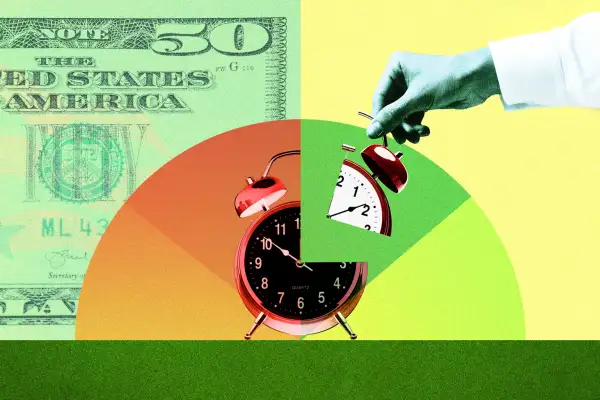Buy Now, Pay Later Loans Can Now Affect Your Credit Score

Buy now, pay later loans may now factor into your credit score.
Fair Isaac Corp., the company behind the widely used FICO score, announced Monday that it will introduce a new scoring model that incorporates buy now, pay later — or BNPL — data for the first time with its upcoming FICO Score 10 BNPL and FICO Score 10 T BNPL. In an email to Money, a spokesperson for FICO says that the two new scores will be offered to lenders alongside the traditional FICO Score for no additional fee.
The new FICO scores will become available in the fall. But according to the company, it's up to the three major credit reporting agencies (Experian, Equifax and TransUnion) to determine when to make the information available to consumers.
The new model, expected to launch this fall, was trained on a dataset of more than 500,000 BNPL users in partnership with Affirm. According to The Wall Street Journal, FICO claims to treat BNPL accounts differently than credit cards, grouping multiple BNPL loans together rather than penalizing consumers for opening several new lines of credit in a short period.
In early testing, FICO said it found that consumers with five or more Affirm loans typically saw their credit scores increase or remained steady under the new model — as long as payments were made on time.
The announcement of the new FICO scores reflects a broader industry trend toward modernizing credit scoring — and highlights how emerging financial tools such as BNPL are reshaping the way consumers build and manage credit.
The rise of BNPL
BNPL lending took off in 2019 and became entrenched during the pandemic era. Lenders like Affirm, Klarna and PayPal offer shoppers a simple way to break down their expenses into installment payments at checkout — sometimes with interest rates as little as 0%.
BNPL companies earn their revenue in part by charging the retailer a fee to offer the installment-payment service at checkout — which then boosts that retailer's sales. BNPL lenders may also charge interest to shoppers.
A major draw to BNPL is that lenders often offer almost-instant approval, no late fees and interest rates lower than credit cards. Up until recently, BNPL purchases were largely left off of credit reports and have not affected credit scores in the same way as a standard loan or credit card purchase.
Critics of BNPL within the lending industry have said that this exclusion has given them an incomplete picture of the financial health of a borrower because the borrower could potentially have several BNPL loans out without the lender knowing.
That’s starting to change.
According to TransUnion, nearly 130 million U.S. consumers have taken out a BNPL loan in the past year. Depending on the BNPL lender, the loan can show up on Experian and TransUnion credit reports.
And in April, BNPL lender Affirm began sending information on all its short-term lending products — including its increasingly popular “Pay in 4” BNPL loan — to the credit bureau Experian. The reporting agency said the move is geared toward “enhancing transparency” in the BNPL market, which has thus far operated largely outside the typical credit and lending ecosystem by not showing up on credit reports.
But while credit bureaus frame these changes as a step toward greater transparency, some consumer advocates remain skeptical about how this data will be used.
“The big three credit bureaus have been pushing BNPL providers to supply this data,” says Chi Chi Wu, a senior attorney at the nonprofit National Consumer Law Center, or NCLC. “Their stock and trade is data, and the more data they can get, the better.”
Most BNPL borrowers already struggle with credit
A federal report from the Consumer Financial Protection Bureau, or CFPB, found that BNPL users are often financially vulnerable, mostly falling into “subprime” or “deep subprime” credit categories, or in other words have credit scores between 300 and 619. (People with credit scores this low are generally not eligible for regular personal loans.)
The CFPB report found that typical BNPL borrowers are taking out more than nine such loans per year, and 63% of them had multiple loans out at the same time. The average BNPL loan amount is about $140.
The credit bureaus say that sharing BNPL data could help these financially vulnerable Americans, especially people who are “credit invisible,” by helping them build up their credit files.
"Credit invisible" is a term used to describe some 25 million Americans — who are often low-income earners and people of color — who have no credit history whatsoever. Without a credit file, they struggle to get basic financial products like credit cards, mortgages and other financing. According to the CFPB report, however, only about 4% of BNPL users are credit invisible. Wu says this suggests that the vast majority of BNPL users already have credit files.
In general, Wu recommends wariness with using BNPL altogether. While people should generally avoid purchases they can’t buy outright, Wu says that using a credit card may be a better option.
“If I'm advising a consumer whether you pay for something with a credit card or BNPL, I'm telling them you use your credit card because of your federal protections,” she says.
For instance, you have the right to dispute credit card charges — but not BNPL ones.
"The real winner in all of this," Wu says, "is the credit bureaus.”
More from Money:
The Hidden Cost of Using Everyday Bills Like Netflix and Rent to Boost Your Credit Score
9 Million Student Loan Borrowers Will Soon Take a 'Significant' Credit Score Hit





